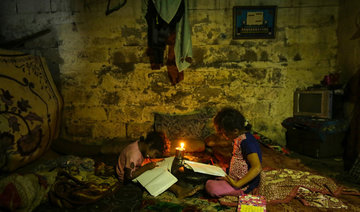GAZA CITY: In recent weeks, Gaza residents have been jolted awake in the dead of night to a raucous mixture of Qur’anic phrases, Islamic supplications and prayers delivered by loudspeakers to their doorsteps.
The “Grand Fajr Campaign” is the work of fervent religious activists, many affiliated with the ruling Hamas militant movement, seeking to spread the message of Islam in an already deeply conservative society. But not everyone is ready to listen.
The Fajr, or “Dawn,” campaign has set off a heated debate over whether it is appropriate to force religion on the masses. One leading religious scholar has even warned that it is un-Islamic to “annoy” people.
Devout Muslims pray five times a day, and activists say they want to make sure that people catch the first and most important of the prayers at their local mosques.
After beginning in several Gaza City neighborhoods, the campaign has spread to areas across the Gaza Strip.
The organizers, mostly mosque committees reporting to the Hamas-controlled Ministry of Religious Affairs, say they want to see the mosques as full at dawn as at the noon prayer on Friday, the highlight of the Islamic week.
Ahmed Hammad, a volunteer in Gaza City’s Tel Al-Hawa neighborhood, said it is paying off, increasing the “rows” of worshippers at the local mosque.
“It used to be a row or half a row of worshippers. But today after the campaign, the number has grown to three rows,” he said.
The campaign comes at a difficult time for Gaza, where despair is widespread among the 2 million inhabitants after a decade-long Israeli-Egyptian blockade and recent restrictions by the West Bank-based Palestinian Authority to squeeze the territory’s Hamas rulers.
Hamas, an Islamic militant group that seeks Israel’s destruction, seized control of Gaza from the Palestinian Authority in 2007 after winning legislative elections a year earlier. Israel says the blockade is necessary to prevent the group from building up its military capabilities, while Palestinian President Mahmoud has tried to pressure the group to yield power.
Though Hamas has offered to relinquish power, reconciliation talks with Abbas have stalled as Gaza’s battered economy continues to deteriorate. In this difficult decade, the Gaza population has grown increasingly conservative and religious.
“The Fajr prayer is important to raise the morale and spirits in this state of strangulation and constraints,” said Abu Aziz Al-Waheidi, who oversees the campaign in 22 mosques in Tal Al-Hawa.
Ismail Haniyeh, Hamas’ supreme leader, has endorsed the effort, with his office distributing pictures showing him and other Hamas officials surrounded by dozens of worshippers after praying at a mosque in the Shati refugee camp, where he lives.
The campaign started last month, shortly after President Donald Trump decided to move the American Embassy in Israel to Jerusalem. The move enraged the Palestinians, who seek east Jerusalem as their future capital. East Jerusalem is home to a hilltop compound revered as Judaism’s holiest site and the third-holiest place in Islam.
When the morning prayer patrols began, residents were perplexed by the raucous sound outside their homes. The only time anything similar occurs is during Ramadan, the Muslim holy month, when drummers wander through the streets waking people to remind the faithful to eat their pre-dawn meal before starting their daylong fasts.
Dozens of mosques now take part in the daily pre-dawn displays. “This is the word of God. They are people urging to do good and worship,” said Saed Al-Shourafa, 63, at the mosque.
But opposition has emerged over the forceful tactics, which include the use of powerful car-mounted loudspeakers.
Saed Abu Hasera, another resident, said it is generally a good thing to encourage people to pray. He said he even found the sounds of a recorder played by one activist to be a “beautiful” way to start the day. But he said they sometimes go too far.
“The banging will awaken children and it will cause confusion,” he said.
Abdel-Bari Khela, an influential Islamic scholar and a Mufti, issued a ruling highlighting the importance of prayer and going to the mosque at dawn. However, he said it is against Islam’s instructions to “annoy” people.
He issued a statement saying that the two traditional calls of prayer issued from the mosque, known as “azans,” is the instruction of Islam.
“Replacing them with illegitimate means such as drums, music and loud sound that makes noise is illegal. If it leads to harm like annoying people or disturbing them, this is forbidden,” he said.
Emerging in the dark from the Abu Honayfa mosque in Tel Al-Hawa on a recent morning, Hamad and a group of young men split into two groups, each carrying a portable loudspeaker. They walked through streets and alleys, with Ahmed calling on people to rise over a microphone, as an Islamic supplication blared from the loudspeaker.
“The sound is not high, not low; it’s very light as you see,” he insisted. “We only go out half or quarter an hour before the azan. How can this be annoying?!“
Keen Islamic prayer activists bring a new dawn to Gaza
Keen Islamic prayer activists bring a new dawn to Gaza

A 98-year-old in Ukraine walked miles to safety from Russians, with slippers and a cane

- Describing her journey, the nonagenarian said she had fallen twice and was forced to stop to rest at some points, even sleeping along the way before waking up and continuing her journey
KYIV, Ukraine: A 98-year-old woman in Ukraine who escaped Russian-occupied territory by walking almost 10 kilometers (6 miles) alone, wearing a pair of slippers and supported by a cane has been reunited with her family days after they were separated while fleeing to safety.
Lidia Stepanivna Lomikovska and her family decided to leave the frontline town of Ocheretyne, in the eastern Donetsk region, last week after Russian troops entered it and fighting intensified.
Russians have been advancing in the area, pounding Kyiv’s depleted, ammunition-deprived forces with artillery, drones and bombs.
“I woke up surrounded by shooting all around — so scary,” Lomikovska said in a video interview posted by the National Police of Donetsk region.
In the chaos of the departure, Lomikovska became separated from her son and two daughters-in-law, including one, Olha Lomikovska, injured by shrapnel days earlier. The younger family members took to back routes, but Lydia wanted to stay on the main road.
With a cane in one hand and steadying herself using a splintered piece of wood in the other, the pensioner walked all day without food and water to reach Ukrainian lines.
Describing her journey, the nonagenarian said she had fallen twice and was forced to stop to rest at some points, even sleeping along the way before waking up and continuing her journey.
“Once I lost balance and fell into weeds. I fell asleep … a little, and continued walking. And then, for the second time, again, I fell. But then I got up and thought to myself: “I need to keep walking, bit by bit,’” Lomikovska said.
Pavlo Diachenko, acting spokesman for the National Police of Ukraine in the Donetsk region, said Lomikovska was saved when Ukrainian soldiers spotted her walking along the road in the evening. They handed her over to the “White Angels,” a police group that evacuates citizens living on the front line, who then took her to a shelter for evacuees and contacted her relatives.
“I survived that war,’ she said referring to World War II. “I had to go through this war too, and in the end, I am left with nothing.
“That war wasn’t like this one. I saw that war. Not a single house burned down. But now – everything is on fire,” she said to her rescuer.
In the latest twist to the story, the chief executive of one of Ukraine’s largest banks announced on his Telegram channel Tuesday that the bank would purchase a house for the pensioner.
“Monobank will buy Lydia Stepanivna a house and she will surely live in it until the moment when this abomination disappears from our land,” Oleh Horokhovskyi said.
Amazon Purr-rime: Cat accidentally shipped to online retailer

- Galena was found safe by a warehouse worker at an Amazon center after vanishing from her home in Utah
LOS ANGELES: A curious cat that sneaked into an open box was shipped across the United States to an Amazon warehouse after its unknowing owners sealed it inside.
Carrie Clark’s pet, Galena, vanished from her Utah home on April 10, sparking a furious search that involved plastering “missing” posters around the neighborhood.
But a week later, a vet hundreds of miles (kilometers) away in Los Angeles got in touch to say the cat had been discovered in a box — alongside several pairs of boots — by a warehouse worker at an Amazon center.
“I ran to tell my husband that Galena was found and we broke down upon realizing that she must have jumped into an oversized box that we shipped out the previous Wednesday,” Clark told KSL TV in Salt Lake City.
“The box was a ‘try before you buy,’ and filled with steel-toed work boots.”
Clark and her husband jetted to Los Angeles, where they discovered Amazon employee Brandy Hunter had rescued Galena — a little hungry and thirsty after six days in a cardboard box, but otherwise unharmed.
“I could tell she belonged to someone by the way she was behaving,” said Hunter, according to Amazon.
“I took her home that night and went to the vet the next day to have her checked for a microchip, and the rest is history.”
What did people eat before agriculture? New study offers insight

- Analysis of forms — or isotopes — of elements including carbon, nitrogen, zinc, sulfur and strontium in these remains indicated the type and amount of plants and meat they ate
WASHINGTON: The advent of agriculture roughly 11,500 years ago in the Middle East was a milestone for humankind — a revolution in diet and lifestyle that moved beyond the way hunter-gatherers had existed since Homo sapiens arose more than 300,000 years ago in Africa.
While the scarcity of well-preserved human remains from the period preceding this turning point has made the diet of pre-agricultural people a bit of a mystery, new research is now providing insight into this question. Scientists reconstructed the dietary practices of one such culture from North Africa, surprisingly documenting a heavily plant-based diet.
The researchers examined chemical signatures in bones and teeth from the remains of seven people, as well as various isolated teeth, from about 15,000 years ago found in a cave outside the village of Taforalt in northeastern Morocco. The people were part of what is called the Iberomaurusian culture.
Analysis of forms — or isotopes — of elements including carbon, nitrogen, zinc, sulfur and strontium in these remains indicated the type and amount of plants and meat they ate. Found at the site were remains from different edible wild plants including sweet acorns, pine nuts, pistachio, oats and legumes called pulses. The main prey, based on bones discovered at the cave, was a species called Barbary sheep.
“The prevailing notion has been that hunter-gatherers’ diets were primarily composed of animal proteins. However, the evidence from Taforalt demonstrates that plants constituted a big part of the hunter-gatherers’ menu,” said Zineb Moubtahij, a doctoral student in archaeology at the Max Planck Institute for Evolutionary Anthropology in Germany and lead author of the study published on Monday in the journal Nature Ecology & Evolution.
“It is important as it suggests that possibly several populations in the world already started to include substantial amount of plants in their diet” in the period before agriculture was developed, added archeogeochemist and study co-author Klervia Jaouen of the French research agency CNRS.
The Iberomaurusians were hunter-gatherers who inhabited parts of Morocco and Libya from around 25,000 to 11,000 years ago. Evidence indicates the cave served as a living space and burial site.
These people used the cave for significant portions of each year, suggesting a lifestyle more sedentary than simply roaming the landscape searching for resources, the researchers said. They exploited wild plants that ripened at different seasons of the year, while their dental cavities illustrated a reliance on starchy botanical species.
Edible plants may have been stored by the hunter-gatherers year-round to guard against seasonal shortages of prey and ensure a regular food supply, the researchers said.
These people ate only wild plants, the researchers found. The Iberomaurusians never developed agriculture, which came relatively late to North Africa.
“Interestingly, our findings showed minimal evidence of seafood or freshwater food consumption among these ancient groups. Additionally, it seems that these humans may have introduced wild plants into the diets of their infants at an earlier stage than previously believed,” Moubtahij said.
“Specifically, we focused on the transition from breastfeeding to solid foods in infants. Breast milk has a unique isotopic signature, distinct from the isotopic composition of solid foods typically consumed by adults.”
Two infants were among the seven people whose remains were studied. By comparing the chemical composition of an infant’s tooth, formed during the breastfeeding period, with the composition of bone tissue, which reflects the diet shortly before death, the researchers discerned changes in the baby’s diet over time. The evidence indicated the introduction of solid foods at around the age of 12 months, with babies weaned earlier than expected for a pre-agricultural society.
North Africa is a key region for studying Homo sapiens evolution and dispersal out of Africa.
“Understanding why some hunter-gatherer groups transitioned to agriculture while others did not can provide valuable insights into the drivers of agricultural innovation and the factors that influenced human societies’ decisions to adopt new subsistence strategies,” Moubtahij said.
Palestinian prisoner in Israel wins top fiction prize

- The mask in the novel’s title refers to the blue identity card that Nur, an archaeologist living in a refugee camp in Ramallah, finds in the pocket of an old coat belonging to an Israeli
ABU DHABI: Palestinian writer Basim Khandaqji, jailed 20 years ago in Israel, won a prestigious prize for Arabic fiction on Sunday for his novel “A Mask, the Color of the Sky.”
The award of the 2024 International Prize for Arabic Fiction was announced at a ceremony in Abu Dhabi.
The prize was accepted on Khandaqji’s behalf by Rana Idriss, owner of Dar Al-Adab, the book’s Lebanon-based publisher.
Khandaqji was born in the Israeli-occupied West Bank city of Nablus in 1983, and wrote short stories until his arrest in 2004 at the age of 21.
He was convicted and jailed on charges relating to a deadly bombing in Tel Aviv, and completed his university education from inside jail via the Internet.
The mask in the novel’s title refers to the blue identity card that Nur, an archaeologist living in a refugee camp in Ramallah, finds in the pocket of an old coat belonging to an Israeli.
Khandaqji’s book was chosen from 133 works submitted to the competition.
Nabil Suleiman, who chaired the jury, said the novel “dissects a complex, bitter reality of family fragmentation, displacement, genocide, and racism.”
Since being jailed Khandaqji has written poetry collections including “Rituals of the First Time” and “The Breath of a Nocturnal Poem.”
He has also written three earlier novels.
Mexican doctor claims victory in $28 Cartier earrings battle

MEXICO CITY: A Mexican man has claimed a victory over French luxury brand Cartier, saying an error allowed him to buy two pairs of earrings for $28 that were supposed to cost nearly $28,000.
After a four-month struggle, doctor Rogelio Villarreal said he had finally received the jewelry, which he accused the company of refusing to deliver after his online purchase in December.
According to Villarreal, he came across the low-priced earrings while browsing Instagram.
“I swear I broke out in a cold sweat,” he wrote on the social media platform X.
Cartier declined to recognize the purchase and offered Villarreal a refund, as well as a bottle of champagne and a passport holder as compensation, according to a company letter shared by the doctor.
But Villarreal refused and decided to take the case to Mexico’s consumer protection agency, which ruled in favor of the doctor.
Cartier accepted the decision, Villarreal announced.
“War is over. Cartier is complying,” he wrote.

















